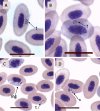Malaria parasites (Plasmodium spp.) infecting introduced, native and endemic New Zealand birds
- PMID: 21842389
- PMCID: PMC3264853
- DOI: 10.1007/s00436-011-2577-z
Malaria parasites (Plasmodium spp.) infecting introduced, native and endemic New Zealand birds
Abstract
Avian malaria is caused by intracellular mosquito-transmitted protist parasites in the order Haemosporida, genus Plasmodium. Although Plasmodium species have been diagnosed as causing death in several threatened species in New Zealand, little is known about their ecology and epidemiology. In this study, we examined the presence, microscopic characterization and sequence homology of Plasmodium spp. isolates collected from a small number of New Zealand introduced, native and endemic bird species. We identified 14 Plasmodium spp. isolates from 90 blood or tissue samples. The host range included four species of passerines (two endemic, one native, one introduced), one species of endemic pigeon and two species of endemic kiwi. The isolates were associated into at least four distinct clusters including Plasmodium (Huffia) elongatum, a subgroup of Plasmodium elongatum, Plasmodium relictum and Plasmodium (Noyvella) spp. The infected birds presented a low level of peripheral parasitemia consistent with chronic infection (11/15 blood smears examined). In addition, we report death due to overwhelming parasitemia in a blackbird, a great spotted kiwi and a hihi. These deaths were attributed to infections with either Plasmodium spp. lineage LINN1 or P. relictum lineage GRW4. To the authors' knowledge, this is the first published report of Plasmodium spp. infection in great spotted and brown kiwi, kereru and kokako. Currently, we are only able to speculate on the origin of these 14 isolates but consideration must be made as to the impact they may have on threatened endemic species, particularly due to the examples of mortality.
Figures



References
Publication types
MeSH terms
Substances
Associated data
- Actions
- Actions
- Actions
- Actions
- Actions
- Actions
- Actions
- Actions
- Actions
- Actions
LinkOut - more resources
Full Text Sources
Medical
Miscellaneous

